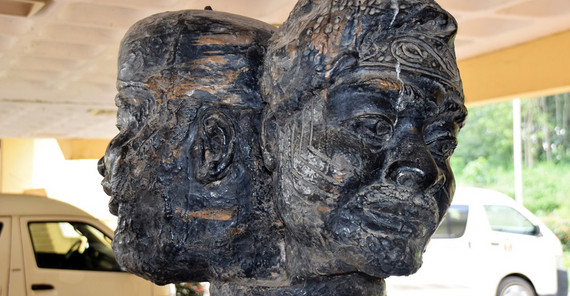October, 13th – Ibadan
Today we explore the history and culture of Nigeria and visit the Museum of National Unity (MNU) in Ibadan, which exhibits an array of valuable artifacts. It was founded in 1973 by the Federal Government, 3 years after the civil war (1967 to 1970) to enhance the unity among Nigerians and opened in 2002 in the times of democratization. This intention can already be observed in the entrance, where a sculpture of three heads representing the three major ethnic groups Yoruba, Hausa and Igbo is displayed.
The museum is divided into four different galleries: the Unity Gallery, Masquerade Gallery, Pottery Gallery and Yoruba Gallery. In the Unity Gallery you can see traditional musical instruments like drums, gongs, rattles and xylophones from all over Nigeria. A curios cylindrical drum that attracts our attention is called “Joko-tofofo“. Garnished with the carving of a naked man, it supposedly cures impotence. Another interesting ritual drum displayed has to be beaten by a priest in order to help an older women to find a husband. So it seems they have a drum for every problem…
Moving on to the Pottery Gallery, we are looking at ceramic vessels of various sizes and shapes. The featured objects are classified by domestic, industrial, ritual, medicinal and ceremonial usage. Quite useful items are the “Kula“, a refrigerator of ancient times and the “Ikoko“ a pot with perforations used for frying and sieving. The exhibits indicate that those Yoruba handiworks already existed around 3,000 years ago. As the curator explains, the demand for pottery gradually decreased and is nowadays mostly reduced to flower pots or decorative items.
In the Yoruba Gallery we learn that according to the “Ori Cult“, Yorubas believe that the head is the most important part of the body. As the essence of one’s personality, the quality of life depends on the quality of the head. These news make totally sense to us, since we already observed the beautiful traditional hats that Nigerians around us wear every day. We also get told that the Yoruba king always has to wear something on his head; if the crown is to heavy than he has to wear a hat instead.
At the end of the tour we are happy to have gained insight into the richness of the Nigerian culture, but at the same time we are concerned to find the museum in such bad conditions. Due to a power shortage and a broken generator, the light doesn’t work and we have to use our flashlights to view the exhibits. Moreover, it seems like the museum doesn’t have a lot of visitors or recognition from outside. Nevertheless, we conceive the curator as highly-skilled and consider the museum worth a visit.
Text: Sandra Hesse, Anna Korneva und Valerie Pobloth
Published online by: Marieke Bäumer
Contact for the online editorial office: onlineredaktionuuni-potsdampde

